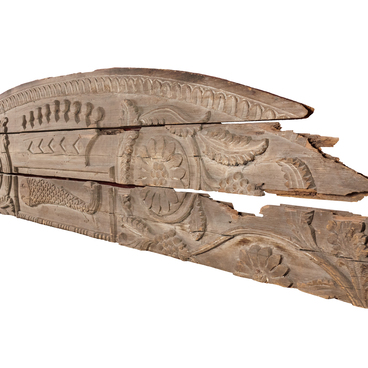The museum’s collection includes buttons from the 19th century. In Rus’, such buttons have been used since the 4th century, but until then they served only as amulets. They looked like hollow metal roundels with a small rock inside, which made them sound like bells ringing when shaken. Usually, these buttons were sewn to clothes and no loops were added, for back then the buttons mostly served as a decoration.
Until the 18th century, the buttons were highly valuable. They were often resewn from one garment to another, passed on by inheritance, as well as contributed to a dowry. There was a Russian saying, ‘A clever girl is as bright as a button.’ There was also another saying regarding laziness, ‘The buttons not cast and the loops not sewn mean that nothing has been done.’ Russian epics also testify to the value of buttons. When someone wanted to emphasize the wealth, they could say, ‘There was a sable coat worth three thousand, and buttons worth seven thousand.’ The buttons were primarily sewn onto outdoor clothes. Russian sarafans (pinafore dresses) also had a lot of buttons on them.
The buttons could be shaped like a ball, a cone, or a pear. They could be embossed or open-worked. Many of them were decorated with carvings, enamel, glass or pearls. In Russia, it was Catherine II who introduced a fashion of buttons richly decorated with gold, silver, pearls or crystal. Each button had its own name. Sometimes they cost more than the apparel they were attached to because they were made of precious metals and gems.
It was believed in Russia since ancient times that buttons revealed the social status of a person. Their number, shape, as well as patterns and engravings on them, could give away the person’s social position and degree of wealth. Moreover, each type of dress had its own number of buttons: 3 to 19 buttons were sewn to a boyar kaftan, and from 8 to 16 — to a fur coat.
The buttons were made of tin, copper or silver, and they were cast in sand or metal molds. The patterns on the buttons were performed in niello — a black mixture of silver, copper and sulfur. There were also engravings, colored enamel inserts, gems and glass. Glass buttons were made by putting heat-softened glass into metal molds. As for the buttons made of mother-of-pearl, wood or bone — they were turned on a lathe.
Until the 18th century, the buttons were highly valuable. They were often resewn from one garment to another, passed on by inheritance, as well as contributed to a dowry. There was a Russian saying, ‘A clever girl is as bright as a button.’ There was also another saying regarding laziness, ‘The buttons not cast and the loops not sewn mean that nothing has been done.’ Russian epics also testify to the value of buttons. When someone wanted to emphasize the wealth, they could say, ‘There was a sable coat worth three thousand, and buttons worth seven thousand.’ The buttons were primarily sewn onto outdoor clothes. Russian sarafans (pinafore dresses) also had a lot of buttons on them.
The buttons could be shaped like a ball, a cone, or a pear. They could be embossed or open-worked. Many of them were decorated with carvings, enamel, glass or pearls. In Russia, it was Catherine II who introduced a fashion of buttons richly decorated with gold, silver, pearls or crystal. Each button had its own name. Sometimes they cost more than the apparel they were attached to because they were made of precious metals and gems.
It was believed in Russia since ancient times that buttons revealed the social status of a person. Their number, shape, as well as patterns and engravings on them, could give away the person’s social position and degree of wealth. Moreover, each type of dress had its own number of buttons: 3 to 19 buttons were sewn to a boyar kaftan, and from 8 to 16 — to a fur coat.
The buttons were made of tin, copper or silver, and they were cast in sand or metal molds. The patterns on the buttons were performed in niello — a black mixture of silver, copper and sulfur. There were also engravings, colored enamel inserts, gems and glass. Glass buttons were made by putting heat-softened glass into metal molds. As for the buttons made of mother-of-pearl, wood or bone — they were turned on a lathe.



